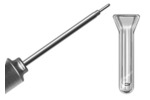- ▶
- Heaters/Source
- ▶
- Agilent Heaters and SensorsMass Spectrometry, Scientific Supplies & ManufacturingScientific Instrument Services 5973 Source Heater Tamper Resistant Allen Wrench 5973/5975 Quad Sensor 5985 Source Heater Assembly Agilent Interface Heater Assembly 5971 Interface Heater

- ▶
- Probes
- LiteratureApplication Notes Adsorbent Resins Guide Mass Spec Tips SDS Sheets FAQ MS Calibration Compound Spectra Manuals MS Links/Labs/ Organizations MS Online Tools Flyers on Products/Services Scientific Supplies Catalog About Us NextAdvance Bullet Blender® Homogenizer Protocols Micro-Mesh® Literature Instrumentation Literature Agilent GC/MS Literature SIS News / E-Mail Newsletter NIST MS Database - Update Notifications

- ▶
- Mass Spec Tips1 - Freon for use in Mass Spectrometer Leak Checking 2 - Mass Spectrometer Probe Cooling 3 - Sample Vials for Direct Probes 4 - Selection of Vacuum Pump Oils for Lowest Mass Spec Background 5 - Determination Linkages in Biomolecules of Disulfide 6 - Transfer of H.P. ChemStation MS and GC Chromatograms from PC to MAC Computer 7 - Repairing Clogged Thermospray Probes 8 - Tuning a Finnigan 5100 to Meet BFB or DFTPP Criteria 9 - H.P. 5971 Transfer Line Tip for Direct Introduction of Capillary Column 10 - Troubleshooting Finnigan 5100 GC/MS Systems 11 - Leak Checking Mass Spectrometers 12 - Elimination of Memory Peaks and GC Background Noise 13 - SuperIncos Mapped Software Print Buffer Lockup 14 - Reduction of Peak Tailing 15 - Electron Multiplier Sensitivity 16 - INCOS Procedure for Calibrating on the Finnigan 4500 17 - Extending Electron Multiplier Life 18 - What techniques or methods do you use to determine if the electron multiplier 19- What techniques or methods do you use to detect vacuum leaks in your mass spectrometer 20 - Extending Lenear Range of the Mass Spec Article - Improving Sensitivity in the HP 5971 Mass Spectrometer - Part 1 and Part 2

- ▶
- 2 - Mass Spectrometer Probe Cooling (This Page)
 Mass Spec Tips is a collection of tips relating to the operation
and service of mass spectrometers. Some of these Tips have been
reported in our newsletter, "The Mass Spec Source."
If you have a question relating to the operation or service of
mass spectrometers or would like to add your comments to the below
tip and would like to have it included in this forum, please contact us.
Input to this database of MS Tips is needed from our readers
to complete this section.
Mass Spec Tips is a collection of tips relating to the operation
and service of mass spectrometers. Some of these Tips have been
reported in our newsletter, "The Mass Spec Source."
If you have a question relating to the operation or service of
mass spectrometers or would like to add your comments to the below
tip and would like to have it included in this forum, please contact us.
Input to this database of MS Tips is needed from our readers
to complete this section.
Author: John J. Manura
Affiliation: Scientific Instrument Services
The probe shafts on many mass spec probes can become excessively hot when the probes are used. Many probe tips reach temperatures in excess of 500 degrees C. In addition the probe tip and shaft can be further heated via thermal conductivity from the mass spectrometer source to which it is mated. When the probe is removed from the source, if the probe shaft is in excess of 200 degrees C the seals of the probe inlet system can be damaged. Many mass spectroscopists have used the same Freon products for cooling the direct probes on mass spectrometers. By inverting the Dust-Off can upside down, the liquid Freon is projected from the compressed gas canister and is directed into the cooling line of the direct probe. The new Dust-Off can be used in the same manner as the old product for this purpose. The Monochlorodifluoro-methane has similar cooling properties as the Dichlorodifluoromethane product when used in this manner. However this new Dust-Off may have some undesirable environmental consequences, and its availability may be limited in the future. Other, safer, products should be found and used to provide cooling of the mass spectrometer probes.
In our laboratory, we normally use compressed air for cooling all of our probes that we manufacture and use in our applications laboratory. The compressed air source can be set to 20 to 40 psi and the air line from this compressed air source attached via leak tight fittings (such as Swagelok fittings) to the gas fitting on the mass spectrometer probe. In the probes that we design at S.I.S. we have incorporated a heat exchanger chamber in the tip of the probe which works very well using compressed air for cooling. We even use compressed air to cool our new High Temperature Probe. In this probe the probe tip can reach 800 degrees C. Compressed air is passed through the probe during the entire heating cycle which maintains the shaft temperature to less than 100 degrees C.
If faster cooling is required, Liquid CO2 could be used but is not normally recommended for cooling the direct probes. The liquid CO2 should be attached to the probe inlet via the same type of leak tight fittings mentioned above. In addition, the user may wish to vent the exhaust of the probe via a second line out of the laboratory to eliminate the possibility of excessive levels of the gas into the laboratory atmosphere. Extreme care must be exercised when using CO2 in this manner for probe cooling due to the low temperatures and pressures involved. Flexible plastic or nylon gas lines cannot be used. Stainless steel lines are recommended and all fittings must be securely fastened. The design of the probe may not permit the use of liquid CO2 . If plastic interconnecting tubing is used inside the probe handle, these lines could easily come undone when CO2 is delivered to the probe. Due to these problems and hazards, liquid CO2 is not normally used for cooling mass spectrometer probes.
Liquid cooling circulators have been used by some manufacturers for cooling mass spectrometer probes. This unit consists of a small pump which continually recirculates a cooled fluid through the mass spectrometer probe. They do a good job of cooling the probe, but cannot be used with most manufacturers probe designs. Most manufacturers of probes have designed their probes for gas cooling only. Liquids cannot be used because the insulated thermocouple and heater wires would become saturated with the liquid and result in electrical shorts to the probe heater and temperature sensing circuits. We have designed all our cooling probes at S.I.S. with a heat exchanger chamber in the probe tip and a completely isolated cooling system. Therefore these probes can be used with both gases as well as liquids for cooling purposes since none of the electrical wires would be exposed to the cooling liquids. We presently do not have a source for a small liquid cooling circulator. However we are trying to find one, and if not available plan on manufacturing one in the near future.


